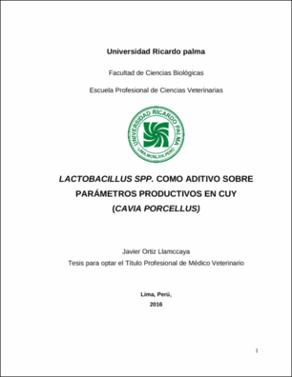| dc.description.abstract | La presente investigación se realizó con el fin de evaluar el efecto probiótico de 3 diferentes dosis de Lactobacillus spp. como aditivo sobre parámetros productivos en Cavia porcellus. Se utilizaron 4 grupos de 8 cuyes machos destetados a las 2 semanas cada uno: 3 tratamientos y 1 control. El primer (T1), segundo (T2) y tercer tratamiento (T3) constaron de dosis diarias de 2.5x108, 2.5x109 y 2.5x1010 ufc del probiótico, respectivamente; para el grupo control (TC) suero fisiológico. El probiótico se obtuvo de un yogurt comercial mediante técnicas de aislamiento, identificación y liofilización. La administración del probiótico y el suero fisiológico fue vía oral e individualmente por 7 semanas; además, de recibir concentrado y forraje como alimento. Se empleó un diseño por bloques completos y aleatorizado, las variables en estudio fueron: peso, incremento de peso, conversión alimenticia y rendimiento de carcasa. Los resultados a las 7 semanas fueron: peso final de T1, T2, T3 y TC, 921, 933, 947 y 913 gr; incremento de peso total de T1, T2, T3 y TC, 640.5, 644.75, 632 y 654.75 gr; índice de conversión alimenticia promedio de T1, T2, T3 y TC, 2.90, 2.83, 3.11 y 2.52; y el rendimiento de carcasa promedio de T1, T2, T3 y TC 73.6%, 72.3%, 71.9% y 72.2%, respectivamente. Al análisis estadístico se encontró que no existe diferencia estadísticas significativas entre los grupos tratamiento y control, en las variables estudiadas. A la necropsia no se encontraron lesiones macroscópicas y los grupos tratamiento dieron resultados negativos de cultivos bacterianos para Salmonella spp. en un 100% de los casos, mientras que el grupo control dio un resultado positivo, lo que demuestra que el probiótico posiblemente puede inhibir el crecimiento de Salmonella.The present investigation was realized in order to evaluate the probiotic effect of 3 different doses of Lactobacillus spp. as additive on productive parameters in Cavia porcellus. There were 4 groups of 8 male guinea pigs weaned at 2 weeks each one: 3 treatments and 1 control. The first (T1), the second (T2) and the third (T3) consist of a daily doses of 2.5x108, 2.5x109 y 2.5x1010 cfu of the probiotic respectively; for the control group (TC) only physiological serum. The probiotic was obtained from a commercial yogurt by isolation, identification and freeze-dry techniques. The administration of the probiotic and the serum was individually and orally for 7 weeks, besides receiving concentrate and forage as food. Was used a complete and randomized blocks design, the variables in study were: weight, gain of weight, food conversion and carcass performance. The results at the 7 weeks were: final weight of T1, T2, T3 and TC, 921, 933, 947 and 913 gr; gain of total weight of T1, T2, T3, TC, 640.5, 644.75, 632 and 654.75 gr; average food conversion index of T1, T2, T3 and TC, 2.90, 2.83, 3.11 and 2.52; and average of carcass performance of T1, T2, T3 and TC, 73.6%, 72.3%, 71.9% and 72.2%, respectively. At the statistical analysis were found that there isn’t significant statistic difference between the treatments and control groups in the study variables. At the necropsy there wasn’t macroscopic injuries and the treatments groups show negative results in specific bacterial cultures for Salmonella spp. in 100% of the cases, while the control group have one positive result, which demonstrate that the probiotic can possibly disable Salmonella's growth. | es_ES |


